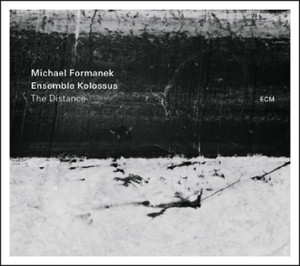 This is an absolutely fabulous release of the kind not many musicians are making any more. Michael Formanek, better known for his quartet work, seems to have a huge and unusual musical vision.
This is an absolutely fabulous release of the kind not many musicians are making any more. Michael Formanek, better known for his quartet work, seems to have a huge and unusual musical vision.
Inspired by the expansive jazz orchestrations of musicians as varied as Charles Mingus, Sun Ra, Anthony Braxton and Henry Threadgill (as well as, needless to say, Duke Ellington), bassist Formanek has created a near-symphonic suite for a large jazz band, 19 pieces to be exact, in combinations that don’t often play together.
Formanek’s The Distance is as epic in scope as (and thematically more varied than) Kamasi Washington’s 2015 smash The Epic. And it’s all about the ensemble, which includes five wind players on everyting from flute and clarinet to baritone sax and bass clarinet; eight brass players on trumpets (among them Ralph Alessi), cornet, and trombones (including bass and contrabass); plus a rhythm section that includes marimba, piano, bass, drums and the secret weapon Mary Halvorson on guitar.
On the album’s one-sheet, Formanek says ” … I wanted a large, rich, chewy sound with this music – and the ensemble’s rhythm section is particularly big, with piano, marimba, guitar, bass and drums. I also wanted a lot of different colors and textures, with some sharp edges occasionally.” Boy, does he get colors, textures and sharp edges on a piece like the eight-part “Exoskeleton” suite. Particularly in the very first movement of the first part, titled “Impenetrable,” with a hard-hitting, precise chart that has a big slice of the ensemble playing in unison. For an old band geek like me, it’s just thrilling, even on record, and I’d love to hear it performed live. You can hear a bit of it at the 2:00 mark on the electronic press kit (EPK) video here:
The Ensemble Kolossus runs through a panoply of postwar jazz styles and some modernist music as well on that “Exoskeleton Parts I-III (Impenetrable, Beneath The Shell, @heart)” suite. The cliché “tour de force” gets tossed around a lot, but this is one work for which it seems suitable. After the raucous intro to Part I, this 21-minute work (longest on the album) settles into a languid, bluesy groove with a saxophone playing a post-bop line over a dense rhythmic stew of guitar, piano, marimba, drums and bass; the big band comes back for a coda before the piece descends below the shell for a spell of modernist interplay between piano and the horns, then a drum solo, a slowly swinging cinematic, bluesy interlude that allows numerous soloists to shine; followed by the final modernist section of pointilist marimba and drums under eerily manipulated horns.
The entire work is like that, flowing from more or less traditional big band-style work into hard-bop workouts, post-bop experimentation, modernist excursions and more. It’s a grand exploration of Formanek’s overflowing cup of musical ideas, by an ensemble that’s curious, game and open to this kind of musical play. The result is never less than interesting and often highly exciting. The Big Band isn’t dead!
(ECM, 2016)
